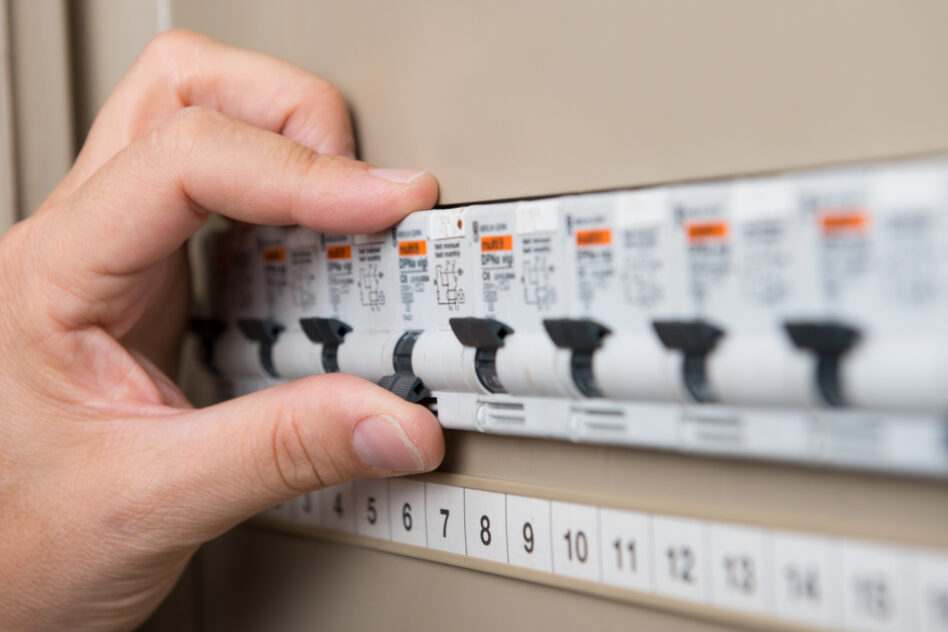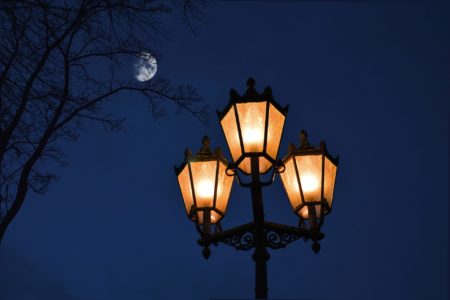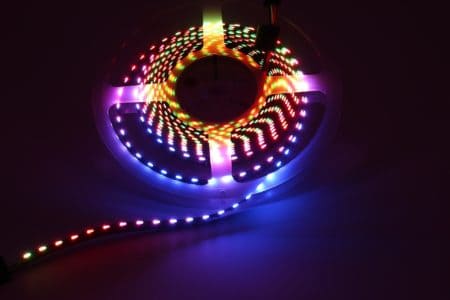Don’t you just hate it when a light switch trips the breaker? Aside from being annoying, the underlying issues may cause serious damage. What can you do about it, and how to keep it from happening again? Let’s find out!
What Does a Tripped Breaker Look Like?
When you open your electrical panel, there should be multiple breakers on a board.
Each of the breakers in the panel regulates a different electrical circuit in your house and has a switch with numbers printed on it. Typically, each one should be labeled with the name of the area that it controls.
Keep in mind that power cannot flow through the circuit until the switch is manually turned back on after a breaker trips. This causes the switch to flip to the “OFF” position automatically.
For example, if the light switch that caused the trip is located in the kitchen, you can easily locate the breaker switch labeled “Kitchen.”
You’ll probably see the “Kitchen” breaker switch tipped to the “OFF” side or right in the middle between “ON” and “OFF.”
What Are the Safety Precautions to Take?
Before we get down to business, let’s make one thing clear: safety is still our top priority.
You may be in a rush to get your problem fixed, but temporarily losing your power supply is so much better than losing an eye or a finger.
Here are some safety tips to keep in mind:
Get Your Hands Ready
Working on electrical systems with wet hands is extremely dangerous. So, we recommend that you start by drying your hands properly before troubleshooting your light switch.
Then, you can wear protective goggles or use electrical-insulating gloves.
Check for Water Deposition
Water won’t always accumulate on the breaker, but it does happen occasionally. That’s why it’s always good to examine your panel carefully. If it seems wet, don’t touch anything.
Don’t Touch a Breaker Switch With High Amperage
You might notice a number on the breaker switch that indicates the amps or the measure of electrical current that flows in that circuit.
If the number is 25 or above, it’s better to leave it to the professionals. Meanwhile, if your breakers aren’t labeled at all, it isn’t recommended to attempt to reset them.
Light Switch Trips Breaker: What To Do?
Sometimes, simply flipping your light switch can trigger a trip on your circuit breaker.
This is a common issue with newly installed lighting systems. However, circuit breaker trips from flipping a light switch may also be caused by a short circuit due to faulty or damaged wires.
Either way, let’s take a look at how you can approach the tripped breaker.
Turn Appliances and Devices Off
Start by unplugging all appliances, lamps, and other gadgets in the affected area.
Adjust Your Circuit Breaker
Go to your electrical service panel and check if a particular breaker has tipped to the “OFF” side.
In some cases, the breaker may not tip completely to the “OFF” position and may sit between both sides. When this happens, you can move the switch over to “OFF” first before pushing it back to the “ON” side.
Now, there is a possibility that the switch will automatically tip back to “OFF” after you’ve just switched it to the “ON” side. If that’s the case, don’t try to reset your breaker once more. Instead, seek help from an expert.
Check Your Breaker Panel
After successfully resetting your breaker, flip your light switch to see if the issue is fixed.
If overloading is the culprit, your power will come back after switching your lights on or plugging your devices one at a time.
There may be instances when the light switch doesn’t turn on, but other plugged-in equipment may receive power. If that happens, you can suspect that the problem might have originated from your light switch.
Know When to Call an Expert
If the previous steps don’t cut it or you’re uncertain about the root cause, it’s best to call your electrician.
Having your breaker trip twice in a row should already sound an alarm, and you shouldn’t try to fix the problem on your own.
The primary concern here is that repeatedly resetting your breaker due to recurrent trips can be risky and may result in overheating.
After all, serious complications and accidents are on the line, including the following hazards:
- Overheating of internal components that may lead to fires
- Visible damages like scorch marks on power outlets, sometimes with the presence of a burning smell and smoke
- Sparks on the breaker
- Odd clicks or buzzing sounds from the outlets or switches
- Explosions
How To Prevent Your Light Switch From Tripping the Breaker?
Since dealing with a light switch that trips the breaker is a hassle, you might want to check out these preventative tips and tricks:
Avoid Overloading One Circuit
Circuit overload is the main reason behind trips. That’s why it’s better to avoid plugging your bulb into one circuit with a ton of connected appliances.
Remember that using an extension cord to maximize connectivity will only make things worse. If you badly need to use multiple devices, try plugging your other devices into a different circuit connection or getting a new circuit installed.
Be sure to unplug devices or appliances that aren’t in use.
Check and Replace Old Wiring
If your electrical wires have been sitting there for many decades and you start to experience frequent trips, they’re probably worn out.
You might even notice that rodents have damaged your wiring. So, it’s good to have your old wires replaced by an electrician.
Install Your Light Switch Properly
We’d recommend double-checking that you’re using compatible fixtures before installing new lights or replacing any part of the lighting setup.
Then your electrician can check that all screws are all tight and wirings are connected properly to reduce the risk of tripping.






